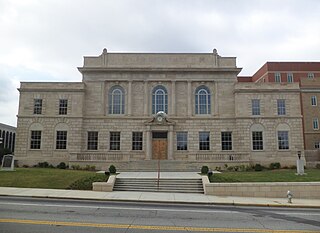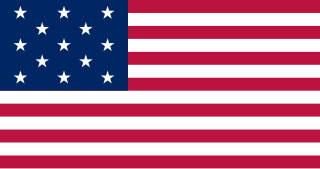Related Research Articles

Carroll County is a county in the West Central region of the State of Georgia. As of the 2020 census, its population was 119,148. Its county seat is the city of Carrollton. Carroll County is included in the Atlanta–Sandy Springs–Roswell metropolitan statistical area and is also adjacent to Alabama on its western border.

The Northwest Ordinance, enacted July 13, 1787, was an organic act of the Congress of the Confederation of the United States. It created the Northwest Territory, the new nation's first organized incorporated territory, from lands beyond the Appalachian Mountains, between British North America and the Great Lakes to the north and the Ohio River to the south. The upper Mississippi River formed the territory's western boundary. Pennsylvania was the eastern boundary.

The Northwest Territory, also known as the Old Northwest and formally known as the Territory Northwest of the River Ohio, was formed from unorganized western territory of the United States after the American Revolution. Established in 1787 by the Congress of the Confederation through the Northwest Ordinance, it was the nation's first post-colonial organized incorporated territory.

The Yazoo lands were the central and western regions of the U.S. state of Georgia, when its western border stretched back to the Mississippi. The Yazoo lands were named for the Yazoo nation, that lived on the lower course of the Yazoo, in what is now Mississippi.

The Mexican Cession is the region in the modern-day Western United States that Mexico previously controlled, then ceded to the United States in the Treaty of Guadalupe Hidalgo in 1848 after the Mexican–American War. This region had not been part of the areas east of the Rio Grande that had been claimed by the Republic of Texas, which had been claiming independence since its Texas Revolution of 1836 and subsequent brief war for independence, followed afterwards a decade later by the American annexation and admitted statehood in 1845. It had not specified the southern and western boundary of the new state of Texas with New Mexico consisting of roughly 529,000 square miles (1,370,000 km2), not including any Texas lands, the Mexican Cession was the third-largest acquisition of territory in U.S. history, surpassed only by the 827,000-square-mile (2,140,000 km2) Louisiana Purchase of 1803 and the later 586,000-square-mile (1,520,000 km2) Alaska Purchase from Russia in 1867.

The Territory of Mississippi was an organized incorporated territory of the United States that was created under an organic act signed into law by President John Adams on April 7, 1798. It was dissolved on December 10, 1817, when the western half of the territory was admitted to the Union as the State of Mississippi. The eastern half was redesignated as the Alabama Territory; it was admitted to the Union as the State of Alabama on December 14, 1819. The Chattahoochee River played a significant role in the definition of the territory's borders. The population increased in the early 1800s from settlement, with cotton being an important cash crop.

The territory of the United States and its overseas possessions has evolved over time, from the colonial era to the present day. It includes formally organized territories, proposed and failed states, unrecognized breakaway states, international and interstate purchases, cessions, and land grants, and historical military departments and administrative districts. The last section lists informal regions from American vernacular geography known by popular nicknames and linked by geographical, cultural, or economic similarities, some of which are still in use today.

The Yazoo land scandal, Yazoo fraud, Yazoo land fraud, or Yazoo land controversy was a massive real-estate fraud perpetrated, in the mid-1790s, by Georgia governor George Mathews and the Georgia General Assembly. Georgia politicians sold large tracts of territory in the Yazoo lands, in what are now portions of the present-day states of Alabama and Mississippi, to political insiders at very low prices in 1794. Although the law enabling the sales was overturned by reformers the following year, its ability to do so was challenged in the courts, eventually reaching the US Supreme Court. In the landmark decision in Fletcher v. Peck (1810), the Court ruled that the contracts were binding and the state could not retroactively invalidate the earlier land sales. It was one of the first times the Supreme Court had overturned a state law, and it justified many claims for those lands. Some of the land sold by the state in 1794 had been shortly thereafter resold to innocent third parties, greatly complicating the litigation. In 1802, because of the ongoing controversy, Georgia ceded all of its claims to lands west of its modern border to the U.S. government. In exchange the government paid cash and assumed the legal liabilities. Claims involving the land purchases were not fully resolved until legislation was passed in 1814 establishing a claims-resolution fund.
Cherokee Nation v. Georgia, 30 U.S. 1 (1831), was a United States Supreme Court case. The Cherokee Nation sought a federal injunction against laws passed by the U.S. state of Georgia depriving them of rights within its boundaries, but the Supreme Court did not hear the case on its merits. It ruled that it had no original jurisdiction in the matter, as the Cherokees were a dependent nation, with a relationship to the United States like that of a "ward to its guardian," as said by Chief Justice Marshall.

The state cessions are the areas of the United States that the separate states ceded to the federal government in the late 18th and early 19th centuries. The cession of these lands, which for the most part lay between the Appalachian Mountains and the Mississippi River, was key to establishing a harmonious union among the former British colonies.

John Ridge, born Skah-tle-loh-skee, was from a prominent family of the Cherokee Nation, then located in present-day Georgia. He went to Cornwall, Connecticut, to study at the Foreign Mission School. He met Sarah Bird Northup, of a New England Yankee family, and they married in 1824. Soon after their return to New Echota in 1825, Ridge was chosen for the Cherokee National Council and became a leader in the tribe.

John Milledge was an American politician. He fought in the American Revolution and later served as United States Representative, 26th Governor of Georgia, and United States Senator. Milledge was a founder of Athens, Georgia, and the University of Georgia. From January to May 1809, Milledge served briefly as President pro tempore of the United States Senate.

The West Florida Controversy included two border disputes that involved Spain and the United States in relation to the region known as West Florida over a period of 37 years. The first dispute commenced immediately after Spain received the colonies of West and East Florida from the Kingdom of Great Britain following the American Revolutionary War. Initial disagreements were settled with Pinckney's Treaty of 1795.

George Rockingham Gilmer was an American politician. He served two non-consecutive terms as the 34th governor of Georgia, the first from 1829 to 1831 and the second from 1837 to 1839. He also served multiple terms in the United States House of Representatives.

The Treaty of Traverse des Sioux was signed on July 23, 1851, at Traverse des Sioux in Minnesota Territory between the United States government and the Upper Dakota Sioux bands. In this land cession treaty, the Sisseton and Wahpeton Dakota bands sold 21 million acres of land in present-day Iowa, Minnesota and South Dakota to the U.S. for $1,665,000.
The Cherokee have participated in over forty treaties in the past three hundred years.
State of Alabama v. State of Georgia, 64 U.S. 505 (1860), is a unanimous ruling by the Supreme Court of the United States which held that the true border between the states of Alabama and Georgia was the average water mark on the western bank of the Chattahoochee River. In coming to its conclusion, the Court defined what constituted the bed and bank of a river. The case has had international repercussions as well. The Supreme Court's definition was adopted by courts in the United Kingdom in the case Hindson v. Ashby (1896) 65 LJ Ch. 515, 2 Ch. 27.

The Marshall Court (1801–1835) issued some of the earliest and most influential opinions by the Supreme Court of the United States on the status of aboriginal title in the United States, several of them written by Chief Justice John Marshall himself. However, without exception, the remarks of the Court on aboriginal title during this period are dicta. Only one indigenous litigant ever appeared before the Marshall Court, and there, Marshall dismissed the case for lack of original jurisdiction.
The Treaty of Indian Springs, also known as the First Treaty of Indian Springs and the Treaty with the Creeks, is a treaty concluded between the Muscogee and the United States on January 8, 1821 at what is now Indian Springs State Park.
References
- ↑ "Treaty regarding Georgia's western lands, 1802". Governor's Subject Files, Executive Dept., Governor, RG 1-1-5, Georgia Archives. Retrieved 13 May 2016.[ permanent dead link ]